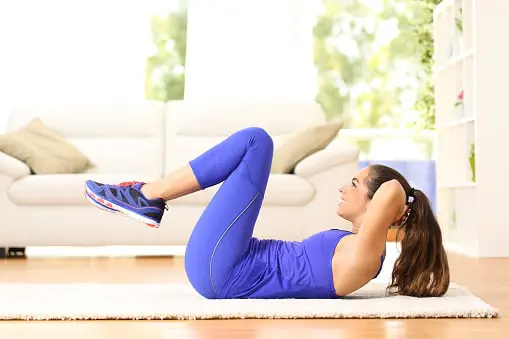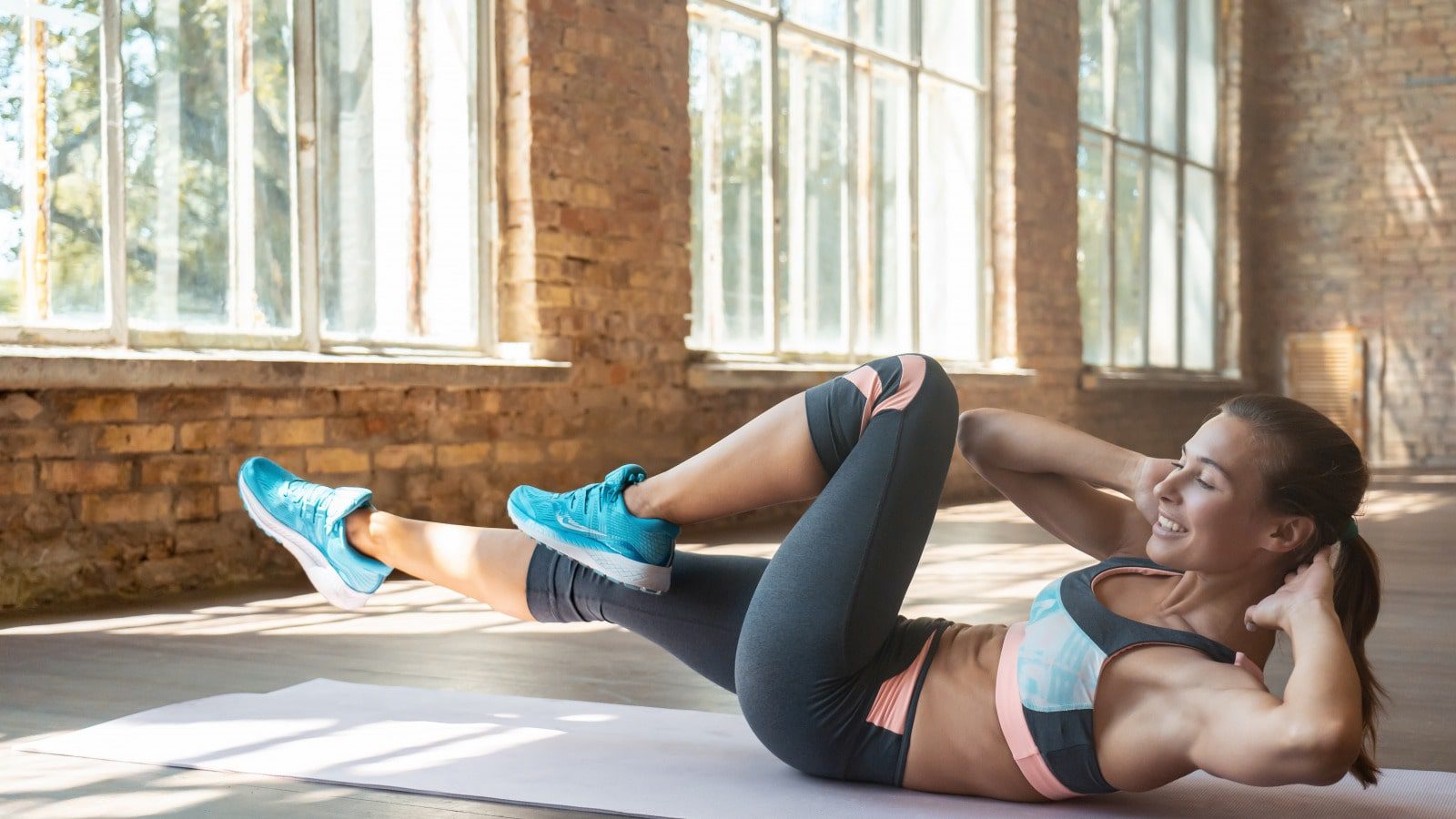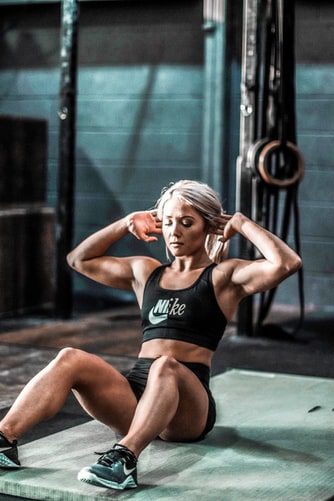
The best online fitness resource you'll ever need. We filter out the BS to ensure you meet your health and fitness goals!

The best online fitness resource you'll ever need. We filter out the BS to ensure you meet your health and fitness goals!

Knee crunches are a core exercise designed to really emphasize the outer core muscles of the rectus abdominis, whilst also putting a lot of tension into the hip flexors. They are pretty straightforward. They also take very little equipment (or even none at all) and only a small amount of practice to perform.
Essentially, they are a form of crunch in which your legs are elevated, bringing an additional element into an otherwise classic core movement.
Knee crunches are very easy to perform (they are harder to perform perfectly, but we’ll get onto this shortly). All you will need is a yoga mat or somewhere else comfortable to lie down, yourself, down, and a little willpower.
To perform knee crunches, simply:

There are a couple of variations you can play with to really get the most out of your core training. I have two particular favourites. These will allow you to work your lower abs and obliques more effectively than the standard version permits.
This does exactly what it says on the label. You perform the full exercise as above, but include a twisting element. Instead of bringing your elbows up to meet their corresponding knees, bring one up to the opposite per rep.
So, for example, begin by coming up, twisting, and bringing your right elbow to your left knee. Then return to the start and repeat on the other side, bringing your left elbow to your right knee.
This will bring an extra plane of motion into the exercise, putting a lot of work into your oblique muscles
We have a similar motion to the knee crunch, here. The legs do all the work with the torso kept still. It can take a lot of risks away from the lower back whilst emphasizing the lower abs quite spectacularly.
To perform knees to chest, simply:

A full range of muscles will come into play during any knee crunch variation, including the muscles of the legs and the lower back. However, it is, of course, primarily a core exercise.
To this end, knee crunches will always work the rectus abdominis (the six pack muscles), with a little emphasis on the transverse abdominis (the deep core muscles). Hip flexors will also work hard. In fact, this is where a lot of beginners feel knee crunches the most as they start out. These will be used to keep your legs elevated through every rep.
As well as these, twisting variations will bring the obliques on board, as mentioned above.
You should never feel the strain in your lower back. If you do, you may need to focus more on keeping it flush to the ground where relevant, or on keeping the chest wide and the spine straight.
In order to really activate the core, you will need to mindfully focus on them. Don’t simply go through the motions. Work on contracting your abs. Otherwise, surrounding muscles can take over, putting you at risk and making the exercise pretty much useless.
There are a few key benefits we are looking for when performing knee crunches, all of which will be elicited when they are performed with good form. Some of the main benefits include:
A strong core leads to better posture as your muscles are far more able to keep your body upright, strong and balanced. It becomes far easier to keep proper alignment through your shoulders, spine, hips and knees with a good, corset-like core holding you together.
This will lead to fewer instances of back pain, to an improved mood. Furthermore, this leads to a more mobile back – aided by the small amount of flexibility gained from performing core exercises – and to a much-decreased risk of injury and falling.
Knee crunches build up good, solid core musculature, working the rectus abdominis and hip flexors in tandem. This will bring about aesthetic benefits in the presence of low body fat percentages, as the six-packs are revealed. A strong core can also reduce your risk of suffering from back pain and various injuries.
Improved core strength will also carry over into your other athletic endeavors…
Strong core musculature is a necessity in any athletic discipline. Every movement you perform runs through the core in some way. All heavy lifts and burst of power launch from the legs, with the power output carrying through the core. A strong core will also improve your endurance as you are able to maintain your body’s natural integrity for longer.
A strong core will also give you greater posture and stability, which are vital in maintaining physical health and athletic capabilities. You will experience lighter levels of fatigue, will see your form in any movement or discipline improve, and will generally perform at a higher level for longer thanks to having a stronger core.
You will find improved balance with a strong core, as you regularly activate muscle fibers and improve mind-muscle connections to the relevant areas. This will lead to improved proprioception as you grow your awareness and feeling through your midsection, giving you far more control over your body and reducing your risk of falls and injuries.
Finally, you will be more stable with a strong core, partly because of your improved balance and proprioception, partly because of your improved strength and posture.

It isn’t all sunshine and roses, however. There are some definite downsides to knee crunches, as there are to crunches in general.
In fact, I would always recommend different exercises, skipping crunches altogether. Though this may not apply to knee crunches and their variations – and though you may personally benefit from performing them – there are better core exercises out there.
Crunches only really work your rectus abdominis to any great degree. These are far less important than your transverse abdominis.
The benefits of having a strong, stable, switched-on deep core are far greater. Even then, the stimulation that crunches bring to your rectus abdominis isn’t that great – there are far more effective ways to work them.
Exercises like hanging knee lifts, leg raises, l-sits, ab wheels and TRX roll-outs will all work your rectus abdominis far more efficiently than crunch variations. They will also all work your transverse abdominis to a terrific degree.
To engage your obliques more, try twisting exercises like lumberjacks, hanging knee lifts with twists, and side planks with leg raises.
The reward of performing knee crunches is therefore relatively low. But what about the risk?
Well, the risk can be quite high, as I’ve already hinted at. You need to make sure that your back is in the right position and that your abs are doing the work.
If not, you will likely hurt your back over time. You will also likely completely switch off the abs, giving them no benefit at all as the surrounding muscles are placed at risk to move your torso through the motions.
Knee crunches are better than regular crunches. The hip flexor element is great. Get your core contractions correct and there are some gains to be made through your abs. However, any of the above-mentioned alternative core exercises will likely serve you a lot better, giving you a much better ab workout whilst putting you at far less risk.